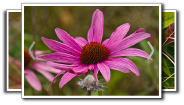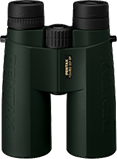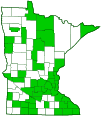tall thimbleweed
(Anemone virginiana var. virginiana)
Conservation • Wetland • Description • Habitat • Ecology • Use • Distribution • Taxonomy
Conservation Status |
|
|||||||
| IUCN Red List | not listed | |||||||
| NatureServe | N5 - Secure SNR - Unranked |
|||||||
| Minnesota | not listed | |||||||
Wetland Indicator Status |
||||||||
| Great Plains | FACU - Facultative upland |
|||||||
| Midwest | FACU - Facultative upland |
|||||||
| Northcentral & Northeast | FACU - Facultative upland |
|||||||
Description |
||
Tall thimbleweed (var. virginiana) is a common and widespread summer wildflower. It occurs in the United States from Maine to Georgia, west to North Dakota and Oklahoma, and in adjacent Canadian provinces. It is common in Minnesota. It is found in open upland woodlands, upland prairies, savannas, and thickets; on riverbanks, rocky stream banks, and roadsides; and in open disturbed areas. It grows under full or partial sun in dry soil. Tall thimbleweed (var. virginiana) is an erect, perennial, 12″ to 27″ (30 to 100 cm) tall forb rising on basal leaves and a single stem from a stout, short, ascending to vertical caudex. A whorl of 1 to 5 basal leaves rises from the ground at the top of the caudex. Each basal leaf is on a 2″ to 13¾″ (5 to 35 cm) long leaf stalk (petiole). The petiole is often purplish and is shallowly grooved above. The leaf blade is broadly inversely egg-shaped in outline and is divided into three leaflets. The terminal leaflet is unstalked or nearly unstalked, inversely egg-shaped or inversely lance-shaped in outline, ¾″ to 3½″ (3 to 9 cm) long, and ¾″ to 2″ (2 to 5 cm) wide, sometimes larger. It is wedge-shaped to broadly wedge-shaped at the base and is often cut at the tip into 3 lobes. The lobes may be shallow or deep, and often have secondary lobes. The ultimate lobes are sharply pointed. The upper and lower surfaces are covered with long, soft, straight hairs, more so on the lower surface. The margins are coarsely toothed with sharp, forward pointing teeth. The lateral leaflets are similar but sometimes deeply divided into 2 segments, causing the leaf blade to appear at first inspection to be divided into 4 or 5 segments. A single flowering stem rises from the caudex at the base of the whorl of leaves. The stem is covered with scattered white hairs and is usually unbranched below the inflorescence. At the top of the stem there are two or three pairs of opposite whorls of inflorescence leaves (bracts). Each whorl has 3 or 4 bracts (together called an involucre). The bracts are conspicuously stalked and are similar to the basal leaves but are smaller. The base of each bract is heart-shaped or kidney-shaped, rarely straight across (truncate). The margins are coarsely toothed on the upper half and sometimes also lobed. The terminal leaflet is light green, elliptic to inversely lance-shaped, ¾″ to 4″ (2 to 10 cm) long, and ¾″ to 2″ (2 to 5 cm) wide. It is wedge-shaped at the base and sharply pointed at the tip. The margins of the terminal leaflet are straight or convex and untoothed on the lower half. A long stalk (peduncle) with a single flower rises from the upper axil of some of the bracts. Each peduncle is 4″ to 12″ long, unbranched, and moderately to densely covered with long, soft, shaggy, unmatted hairs. A secondary involucre on each peduncle appears at least 4¼″ (11 cm) below the flower. The bracts of the secondary involucre are much smaller. The terminal leaflet is no more than ¾″ (2 cm) in length. The inflorescence is a single flower at the end of each peduncle. Each flower is ¾″ to 1″ (20 to 25 mm) in diameter. There are no petals, usually 5 sepals, and 50 to 70 stamens. At the center of the flower there is a dense cluster of green pistils. The sepals are petal-like, oblong to egg-shaped or inversely egg-shaped, white or greenish-white, ¼″ to ¾″ (6.5 to 20 mm) long, and ⅛″ to ⅜″ (2.5 to 10 mm) wide. They are thinly hairy on the outside, hairless or nearly hairless inside. The stamens form a ring around the base of the cluster of pistils. The anthers are yellow and 1⁄32″ to 1⁄16″ (1.0 to 1.7 mm) long. They turn light brown after shedding pollen. The infructescence is a dense, cylinder-shaped fruiting head. The cluster of pistils elongates, becoming ½″ to 1⅛″ (12 to 28 mm) long and 7⁄16″ to 9⁄16″ (11 to 14 mm) in diameter. Its shape resembles a thimble. This is the feature that gives the species its common name. The “thimble” is less than twice as long as wide. It appears very prickly. The fruit is an egg-shaped to egg cylinder-shaped, 1⁄16″ to ⅛″ (2.0 to 3.7 mm) long seed capsule (achene). Dense woolly hairs conceal only the lower half of the achene. When the achenes mature in the fall the fruiting head appears cottony and remains so all winter. |
||
Height |
||
12″ to 40″ (30 to 100 cm) |
||
Flower Color |
||
White |
||
Similar Species |
||
River anemone (Anemone virginiana var. alba) involucral bracts are usually truncate at the base, sometimes heart-shaped or kidney-shaped. The terminal leaflet is dark green. The margins of the terminal leaflet are concave to straight on the lower half. The fruiting head is smaller, 5⁄16″ to ⅜″ (8 to 10 mm) in diameter. Tall thimbleweed (Anemone virginiana var. cylindroidea) involucral bracts are more or less light green. The flowers are much smaller. The sepals are (5 to 10 mm) long and are densely tomentose. The anthers are shorter, no more than 1⁄32″ (1.2 mm) long. The fruiting head is smaller, ¼″ to 7⁄16″ (7 to 11 mm) in diameter. |
||
Habitat |
||
Moderately moist to dry. Open upland woodlands, upland prairies, savannas, thickets, riverbanks, rocky stream banks, roadsides, and open disturbed areas. Full or partial sun. |
||
Ecology |
||
Flowering |
||
June to August |
||
Pests and Diseases |
||
|
||
Use |
||
Toxicity |
||
Skin contact with the sap causes inflammation and blistering. Eating will cause severe pain in the mouth, vomiting, and diarrhea, but it is not fatal unless taken in large quantities. |
||
Distribution |
||||
|
Sources |
|||
| 5/31/2022 | ||||
Nativity |
||||
Native |
||||
Occurrence |
||||
Common and widespread |
||||
Taxonomy |
|||
| Kingdom | Plantae (Plants) | ||
| Division | Tracheophyta (Vascular Plants) | ||
| Subdivision | Spermatophytina (Seed Plants) | ||
| Class | Magnoliopsida (Dicots) | ||
| Superorder | Ranunculanae | ||
Order |
Ranunculales (Buttercups, Poppies, and Allies) | ||
Family |
Ranunculaceae (Buttercup) | ||
| Subfamily | Ranunculoideae (Anemones, Buttercups, Larkspurs and Allies) | ||
| Tribe | Anemoneae (anemones and allies) | ||
Genus |
Anemone (anemones and thimbleweeds) | ||
| Species | Anemone virginiana (tall thimbleweed) | ||
Synonyms |
|||
Common Names |
|||
tall anemone tall thimbleweed Virginia anemone |
|||
Glossary
Achene
A dry, one-chambered, single-seeded seed capsule, formed from a single carpel, with the seed attached to the membranous outer layer (wall) only by the seed stalk; the wall, formed entirely from the wall of the superior ovary, does not split open at maturity, but relies on decay or predation to release the contents.
Bract
Modified leaf at the base of a flower stalk, flower cluster, or inflorescence.
Caudex
A short, thickened, woody, persistent enlargement of the stem, at or below ground level, used for water storage.
Involucre
A whorl of bracts beneath or surrounding a flower, flower head, or flower cluster.
Peduncle
In angiosperms, the stalk of a single flower or a flower cluster; in club mosses, the stalk of a strobilus or a group of strobili.
Petiole
On plants: The stalk of a leaf blade or a compound leaf that attaches it to the stem. On ants and wasps: The constricted first one or two segments of the rear part of the body.
Sepal
An outer floral leaf, usually green but sometimes colored, at the base of a flower.
Tomentose
Densely covered with short, soft, matted or tangled, woolly, usually white or silvery hairs.
Truncate
Terminating abruptly as if cut off, as with a leaf base.
Visitor Photos |
|||||
Share your photo of this plant. |
|||||
| This button not working for you? Simply email us at info@MinnesotaSeasons.com. Attach one or more photos and, if you like, a caption. |
|||||
|
|||||
MinnesotaSeasons.com Photos |
|||||
|
|||||

Slideshows |
||

Visitor Videos |
|||
Share your video of this plant. |
|||
| This button not working for you? Simply email us at info@MinnesotaSeasons.com. Attach a video, a YouTube link, or a cloud storage link. |
|||
Other Videos |
|||

Visitor Sightings |
|||||
Report a sighting of this plant. |
|||||
| This button not working for you? Simply email us at info@MinnesotaSeasons.com. Be sure to include a location. |
|||||
|
|||||
MinnesotaSeasons.com Sightings |
|||||
|
|||||

|
Created: Last Updated: © MinnesotaSeasons.com. All rights reserved. |
